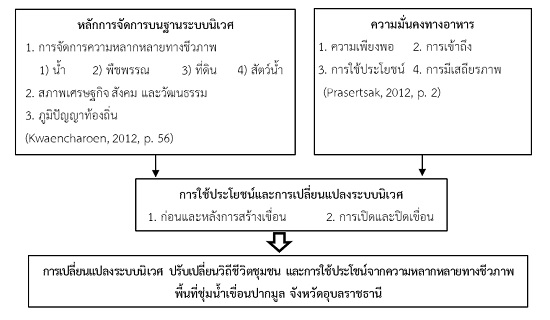THE IMPACT FROM ECOSYSTEM CHANGE, CHANGE THE WAY OF LIFE IN THE COMMUNITY LIFESTYLE AND MAKE USE OF BIODIVERSITY AT PAK MOON WETLANDS UBON RATCHATHANI PROVINCE
DOI:
https://doi.org/10.14456/nrru-rdi.2021.31Keywords:
Ecosystem changes, Community lifestyle, Biodiversity, WetlandsAbstract
In this mixed-method, its objective is to study 1) the impact of wetland ecosystem changes on biodiversity, food security, and local culture, and 2) the change of community life culture of diversity utilization in Wetlands, the area of 3 districts in Pak Moon Dam, Ubon Ratchathani Province; Khong Chiam, Sirindhorn, and Phibun Mangsahan districts. 100 participants of each district were found as simple sampling. The questionnaire, audited for quality (IOC=1.00) were used to collect data by interviewing with community participation and organizing seminars with relevant agencies. Analyzing opinion data with basic statistics such as number and percentage for an interview and conferencing was used as the content analysis.
The results showed that water quality in terms of dissolved oxygen content is less than 4 milligrams per liter to effects the livelihood of aquatic animal bacteria affects the production of tap water. The nitrogen and phosphorus affected the rapid growth of algae and water quality, most people were affected by fish, shellfish, and shrimp fishing in forest, bung, forest, riverside, and aquatic plants (95.56% and 77.22%). Livelihoods and the environment were scrapped (63.67%, 60.00, 56.00, and 53.67%), the same flood problem (48.33%) has lost the traditional wisdom of wetland utilization, which problems and conflicts among villagers regarding water management in a chain were found, there were modifications to the lifestyle of migrated workers into the poor area.
References
Ashcroft, B., & Ahluwalia, P. (1999). Edward Said: The Paradox of Identity. New York : Routledge.
Baimai, V. (2017). Thai Society on Biodiversity. The Research Community. Retrieved February 6, 2021, from http://rescom.trf.or.th/display/keydefault.aspx?id_colum=1074 (In Thai)
Biodiverrsity-based Economy Development Office (Public Organization). (2017). Bio-based Economic Development Strategy Framework of 20 years. B.E. 2560-2579. Retrieved February 6, 2021, from https://www.bedo.or.th/bedo/backend/upload/content/2018_03/1520496784_7221.pdf (In Thai)
Chaitrong, P., & Manorom, K. (2014). Dynamics, movement and struggle to restore the way of life of the community that has been affected by the Pak Mun dam. Journal of Humanities and Social Ubon Ratchathani University, 5(2), 81-111. (In Thai)
Chantree, P., & Jitcharoen, J. (2011). Impacts of Closing-Opening Gate of Pakmun Dam on Water Quality of Mun River. UBU Engineering Journal, 4(1), 16-24. (In Thai)
Couldry, N. (2000). Inside Culture: Re-Imagining the Method of Cultural Studies. London : Sage.
Department of Marine and Coastal Resources. (2014). Why do we need to open Pak Mun Dam?. Retrieved February, 6, 2014, from https://www.dmcr.go.th/detailAll/1949/rn/0 (In Thai)
Homchan, A., Udomchok, W., Patthananurak, K., Phianchana, A., Thepprasit, C, Chaturabon, T., & Ketschinda, K. (2013). The research project of application of geographic information system for analysis and planning of flood risk, Ubon Ratchathani Province. A complete study report. Kasetsart University, Bangkok. (In Thai)
Hongsuwan, P. (2014). Dong Phu Din: The Sacred Narrative and a Social Process on Building a Meaning of Community Rights. Journal of Mekong Scoieties, 10(3), 167-192. (In Thai)
Kwancharoen, K., et al. (2012). Self-Management Community on an ecological base. Bangkok : Foundation for Sustainable Development. (In Thai)
Ludwig, J. A., & Reynolds, J. F. (1998). Statistical Ecology. New York : John Wiley and Sons.
Ministry of Natural Resources and Environment. (2017). Strategic Plan of the Ministry of Natural Resources and Environment 20 years B.E. 2560-2579. Retrieved February 6, 2021, from http://www.mnre.go.th/th/index (In Thai)
Office Of Natural Resources and Environmental Policy and Planing. (2017). Biodiversity Management Action Plana 2017-2021. Bangkok : Ministry of Natural Resources and Environment. (In Thai)
Pilasombut, K. (2014). The Suitable Communities Way of Life After the Construction of Phimai Dam in Nakhon Ratchasima Province. Thesis, Doctor of Philosophy Program in Environment Education, Valaya Alonkorn Rajabhat University under the Royal Patronage, Pathum Thani. (In Thai)
Poplin, D. E. (1979). Social Problems. New York : Random House.
Prasertsak, W. (2012). FOOD SECURITY: CONCEPTS AND DEFINTINONS. Retrieved August 20, 2014, from http://www.polsci.tu.ac.th/fileupload/36/24.pdf (In Thai)
Sumnaunyen, K., Srinate, P., & Akarapattananukul, Y. (2013). Pak Mun Dam and its Impacts on the Pattern of Local Livelihood. Songklanakarin Journla of Social Sciences and Humanities, 19(4), 71-107. (In Thai)
Supakosol, S., & Pagdee, A. (2012). Importance of wethlands to local economy. The 13th Graduate Research Conference (pp. 503-511). Khon Kaen : Khon Kaen University. (In Thai)





